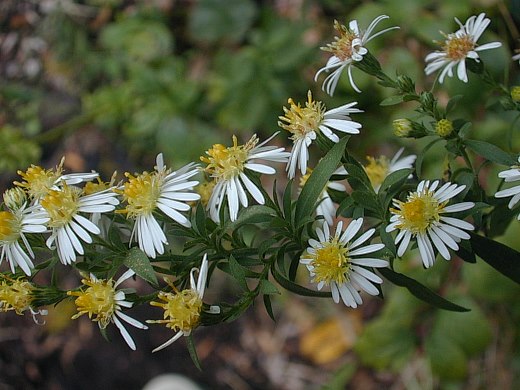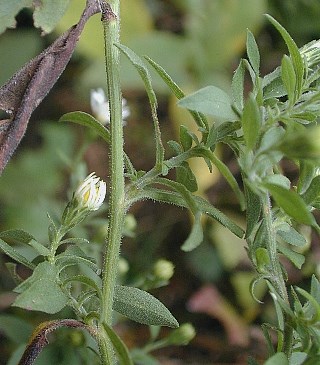Description: This perennial wildflower is 1½–3' tall. Each plant has a central stem that develops from the rootstock (less often, there are 2-3 such stems), which branches from below the middle. During the flowering period, short secondary stems develop from the axils of the leaves. These stems are terete, mostly light green, and pubescent; sometimes they have longitudinal ridges. The alternate leaves are up to 3½" long and 1" across; they are lanceolate, oblanceolate, or narrowly ovate with margins that are slightly toothed or smooth. The upper surface of each leaf is medium green and hairless, while the lower surface is light green and finely short-pubescent. Sometimes there are longer hairs along the central vein on the underside of each leaf. The leaves are sessile against their stems and their outer tips are somewhat blunt.

The upper stems
terminate in elongated panicles of flowerheads. Each flowerhead spans
about ½" across, consisting of 15-25 white ray florets and a similar
number of disk florets. The disk florets are initially pale yellow, but
they later become reddish purple; each disk floret is tubular in shape
with 5 spreading lobes along its upper rim. Surrounding the base of
each flowerhead, there is an overlapping series of small floral bracts
(phyllaries). These floral bracts are linear in shape, evenly green
from top to bottom, and appressed or slightly spreading. Each
flowerhead has a short peduncle up to 1" long. In addition to the
flowerheads, the branches of the panicle have numerous leafy bracts.
These leafy bracts are similar in appearance to the leaves, except
smaller in size. The blooming period occurs from late summer into the
fall and lasts about 1-2 months. Each flowerhead is replaced by a dense
cluster of small achenes. Each achene is bullet-shaped with a small
tuft of white hairs at its apex. The achenes are distributed by the
wind. The root system is fibrous and long-rhizomatous. Small colonies
of plants are occasionally formed.
Cultivation:
The preference is partial or dappled sunlight, moist to mesic
conditions, and a fertile loamy soil. Other kinds of soil are also
tolerated.

Range & Habitat:
The native Ontario Aster is occasional to locally common throughout
Illinois (see Distribution
Map). Habitats include open woodlands, woodland openings,
woodland borders, partially shaded cliffs, areas along woodland paths,
powerline clearances in wooded areas, low areas along woodland streams,
savannas, moist meadows, and
abandoned fields. This aster benefits from disturbance if it reduces
excessive shade from canopy trees.
Faunal Associations:
The nectar and/or pollen attract various insects, including bumblebees,
little carpenter bees (Ceratina spp.), leaf-cutting
bees (Megachile spp.), Halictid bees,
Syrphid flies, and butterflies. A long-horned bee, Melissodes
dentriventris, is an oligolectic floral visitor of this and
other asters (Symphyotrichum
spp.). These insects cross-pollinate the flowers.
Other insects, including aphids, plant bugs, leaf beetles, etc., feed
destructively on asters (see Insect Table); there are also a
large number of moth caterpillars that feed on various parts of asters
(see Moth
Table). The Ruffed Grouse and Wild Turkey feed on the leaves
and seeds of these plants to a limited extent; White-Tailed Deer and
Cottontail Rabbits also feed on the foliage to a limited extent.
Photographic Location:
A powerline clearance at Busey Woods in Urbana, Illinois.
Comments:
This aster has a rather ordinary appearance and it is often omitted in
many wildflower guides. Ontario Aster (Symphyotrichum ontarionis)
resembles several other asters (Symphyotrichum spp.)
with small white flowerheads and they
often occur in the same or similar habitats. In general, Ontario Aster
can be distinguished from these other species by the even pubescence of
its stems and the even canescence (short fine pubescence) on the
underside of its leaves. Other similar asters have stems with lines of
hair and the undersides of their leaves are either hairy along the
major veins or hairless. The flowerheads of Ontario Aster have 15-25
ray florets and its floral bracts are evenly green from top to bottom.
Other similar asters have fewer ray florets (10-15) or their
floral bracts have a diamond-shaped pattern near their tips that is
dark green. Ontario Aster also has an abundance of leafy green bracts
along the branches of its panicles, while the bracts of other asters
are smaller in size and more scale-like in appearance. Sometimes
Ontario Aster hybridizes with similar species of asters, which
increases the difficulty of identification. A scientific synonym of
this species is Aster
ontarionis.